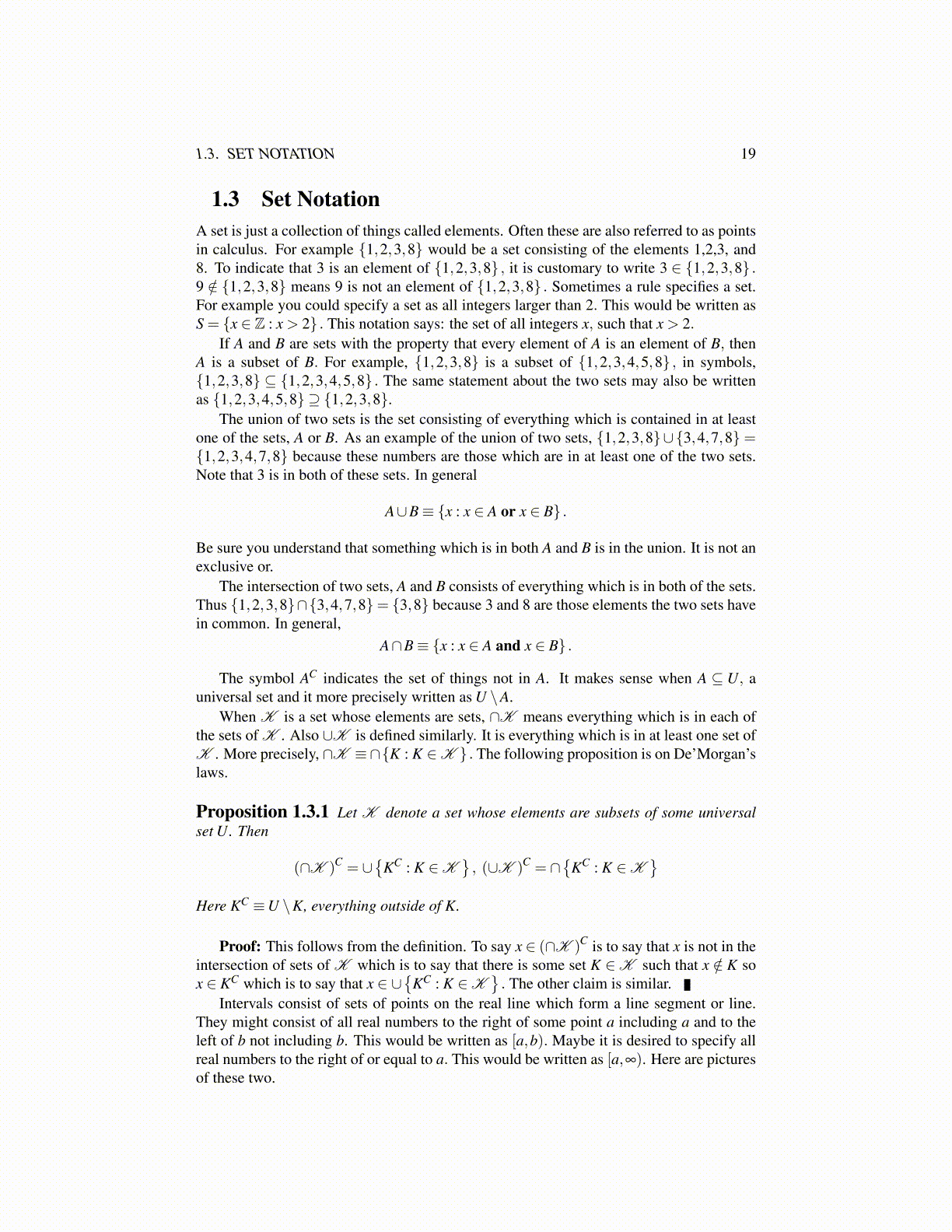
1.3. SET NOTATION 19
1.3 Set NotationA set is just a collection of things called elements. Often these are also referred to as pointsin calculus. For example {1,2,3,8} would be a set consisting of the elements 1,2,3, and8. To indicate that 3 is an element of {1,2,3,8} , it is customary to write 3 ∈ {1,2,3,8} .9 /∈ {1,2,3,8} means 9 is not an element of {1,2,3,8} . Sometimes a rule specifies a set.For example you could specify a set as all integers larger than 2. This would be written asS = {x ∈ Z : x > 2} . This notation says: the set of all integers x, such that x > 2.
If A and B are sets with the property that every element of A is an element of B, thenA is a subset of B. For example, {1,2,3,8} is a subset of {1,2,3,4,5,8} , in symbols,{1,2,3,8} ⊆ {1,2,3,4,5,8} . The same statement about the two sets may also be writtenas {1,2,3,4,5,8} ⊇ {1,2,3,8}.
The union of two sets is the set consisting of everything which is contained in at leastone of the sets, A or B. As an example of the union of two sets, {1,2,3,8}∪{3,4,7,8} ={1,2,3,4,7,8} because these numbers are those which are in at least one of the two sets.Note that 3 is in both of these sets. In general
A∪B ≡ {x : x ∈ A or x ∈ B} .
Be sure you understand that something which is in both A and B is in the union. It is not anexclusive or.
The intersection of two sets, A and B consists of everything which is in both of the sets.Thus {1,2,3,8}∩{3,4,7,8}= {3,8} because 3 and 8 are those elements the two sets havein common. In general,
A∩B ≡ {x : x ∈ A and x ∈ B} .
The symbol AC indicates the set of things not in A. It makes sense when A ⊆ U, auniversal set and it more precisely written as U \A.
When K is a set whose elements are sets, ∩K means everything which is in each ofthe sets of K . Also ∪K is defined similarly. It is everything which is in at least one set ofK . More precisely, ∩K ≡∩{K : K ∈ K } . The following proposition is on De’Morgan’slaws.
Proposition 1.3.1 Let K denote a set whose elements are subsets of some universalset U. Then
(∩K )C = ∪{
KC : K ∈ K}, (∪K )C = ∩
{KC : K ∈ K
}Here KC ≡U \K, everything outside of K.
Proof: This follows from the definition. To say x ∈ (∩K )C is to say that x is not in theintersection of sets of K which is to say that there is some set K ∈ K such that x /∈ K sox ∈ KC which is to say that x ∈ ∪
{KC : K ∈ K
}. The other claim is similar.
Intervals consist of sets of points on the real line which form a line segment or line.They might consist of all real numbers to the right of some point a including a and to theleft of b not including b. This would be written as [a,b). Maybe it is desired to specify allreal numbers to the right of or equal to a. This would be written as [a,∞). Here are picturesof these two.